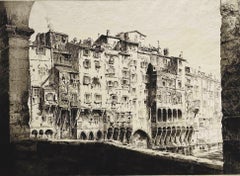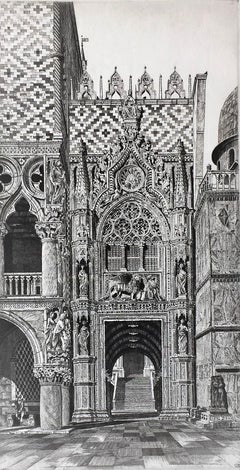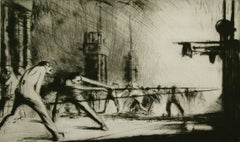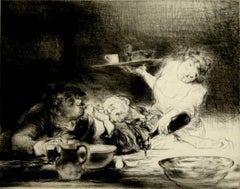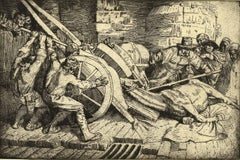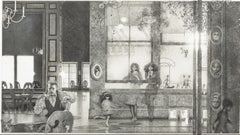Allinson Gallery, Inc. Interior Prints
to
8
4
5
Overall Width
to
Overall Height
to
10
1
6
2
1
1
1
11
1
1
3
2
1
5
4
8
5
5
4
3
2
2
2
1
1
1
1
1
1
1
10
9
9
1
11
Politics
By Edmund Blampied
Located in Storrs, CT
Politics (Tonnere de Brest). 1926. Drypoint. Appleby 108. 7 x 9 (sheet 10 1/2 x 15 1/2). A rich impression printed on cream wove paper with full margins. Illustrated: Salaman, Modern...
Category
Early 20th Century Modern Figurative Prints
Materials
Drypoint, Etching
$1,250 Sale Price
28% Off
The Letter
By Edmund Blampied
Located in Storrs, CT
The Letter. 1921. Drypoint. Appleby 107. 7 x 9 3/8 (sheet 10 1/2 x 15 7/16). Edition 100. Illustrated: Fine Prints of the Year, 1925; Salaman, Modern Masters of Etching: Edmund Blamp...
Category
Early 20th Century Modern Figurative Prints
Materials
Drypoint, Etching
$1,250 Sale Price
28% Off
From the Ponte Vecchio
By John Taylor Arms
Located in Storrs, CT
From the Ponte Vecchio, Florence. 1925. Etching and aquatint. Fletcher catalog 159. state ii. Image: 11 1/8 x 15 1/4 (sheet 13 3/8 x 18 1/4). Edition 160 in this state (total edition...
Category
1930s American Modern Landscape Prints
Materials
Etching, Aquatint
$1,600 Sale Price
20% Off
Enchanted Doorway, Venezia (La Porta della Carta, Venezia '29)
By John Taylor Arms
Located in Storrs, CT
Enchanted Doorway, Venezia (La Porta della Carta, Venezia '29). 1930. Etching. Fletcher catalog 227 state ii. 12 3/8 x 6 9/16 (sheet 15 13/16 x 9 15/16). Edition 148 in this state (...
Category
1920s American Modern Landscape Prints
Materials
Etching
$1,200 Sale Price
20% Off
France at her Furnaces
By James McBey
Located in Storrs, CT
1917. Etching. Hardie 175. 8 x 15 (sheet 10 1/8 x 16 15/16). Edition 76. Slight mat line; otherwise excellent condition. A rich impression printed on antique laid paper with full m...
Category
1910s Modern Interior Prints
Materials
Drypoint, Etching
Vin Rouge (Red Wine)
By Edmund Blampied
Located in Storrs, CT
1932. Drypoint. Appleby 167. 9 1/4 x 11 5/8 (sheet 11 3/8 x 17 15/16). Edition 100 #48. Mat line, well outside the image; otherwise excellent condition. A rich impression with drypo...
Category
1930s Modern Interior Prints
Materials
Drypoint
$1,750 Sale Price
30% Off
Night Time in a Stable.
By Edmund Blampied
Located in Storrs, CT
Night Time in a Stable. 1927-28. Drypoint. Appleby 131. 10 1/8 x 12 1/8 (sheet 11 1/2 x 16 1/2). Edition 100. Illustrated: Print Collector's Quarterly 25 (1...
Category
Early 20th Century Modern Animal Prints
Materials
Drypoint, Etching
Returning to the Stable.
By Edmund Blampied
Located in Storrs, CT
Returning to the Stable. 1920. Drypoint. Appleby 64. 8 3/4 x 12 1/4 (sheet 11 7/16 x 16 1/8). Edition 100. A rich impression printed on cream laid paper wi...
Category
1920s Modern Interior Prints
Materials
Drypoint, Etching
$800 Sale Price
36% Off
Soup
By Edmund Blampied
Located in Storrs, CT
Soup. 1920. Drypoint. Appleby 65. 9 x 8 1/8 (sheet 15 x 11 9/16). Edition 100. Illlustrated: Print Collector's Quarterly 13 (1926): 85. Signed in pencil.
Edmund Blampied was a painter, etcher, lithographer and sculptor. Born in 1886 to a family of three boys in St. Martin, Jersey, Blampied became interested in drawing at an early age. After visiting the studio of John Helier Lander in 1899, Blampied decided to make a career as an artist. In 1903 he went to London to attend Lambeth Art School, where he studied etching under Walter Seymour.
In 1905, he joined the Daily Chronicle as an artist. In that year he was awarded a scholarship to Bolt Court Scool of Photo-engraving and Lithography.
In 1912 he left the Chronicle and established his own studio. He earned a living by illustrating novels and short stories.
In 1913, he had his first exhibition at the Leicester Gallery in London. The following year he married Marianne Van Abbé.
During the 1920's, he became a member of the Royal Society of Painter-Etchers and Engravers. During the 1920s Blampied became a member of the Royal Society of Painters-Etchers and Engravers and exhibited in London to critical acclaim. He produced a folio of comic drawings in the 1930s which was published in New York in 1934 and another that was published in London in 1936. The Keeper of Prints and Drawings at the British Museum published a mongraph on his work. His London exhibitions were highly successful.
In 1938, he moved to Bulwarks, St.Aubin in Jersey, but at the onset of the Occupation, had to relocate to Route Orange, St. Brelade. remained there throughout World War II during the German Occupation, despite the fact that his wife was Jewish. During the Occupation he designed bank...
Category
1920s Modern Figurative Prints
Materials
Drypoint, Etching
Portrait of Albert Schweitzer.
By Arthur William Heintzelman
Located in Storrs, CT
Portrait of Albert Schweitzer. Etching. 11 3/4 x 9 3/4 (sheet 16 1/4 x 14). Illustrated: Beall, American Prints in the Library of Congress, page 205....
Category
1950s American Modern Interior Prints
Materials
Etching, Drypoint
$750 Sale Price
50% Off
Sportsmen
By Louis Legrand
Located in Storrs, CT
Sportsmen. 1908. Etching and drypoint. Exsteens 271.i/ii. 11 1/4 x 5 3/4 (sheet 17 3/8 x 12 1/4). Series: Les Bars. From the first state edition of 30 proofs with the remarque sketch...
Category
Early 1900s Post-Impressionist Figurative Prints
Materials
Drypoint, Etching
$800 Sale Price
54% Off
Related Items
Knackers
By William Strang, R.A., R.E.
Located in New Orleans, LA
Binyon 232 - A fine impression in fine condition in an edition of 55 signed and inscribed by the artist.
Strang was a prolific printmaker and across his lifetime produced over 750 o...
Category
1890s Modern Figurative Prints
Materials
Etching
Interiors I: Family Reunion — A penetrating scene with a hidden homage to Eadwea
By Peter Milton
Located in Middletown, NY
Interiors I: Family Reunion
1984
Resist ground etching and engraving on BFK Rives wove paper, 20 x 36 inches (501 x 913 mm), full margins. Signed, titled, dated and numbered 49/175 in pencil, lower margin. In excellent condition with minor mat tone. A luminous, rich, and well-inked impression of this haunting image, with astonishing detail and depth. Framed handsomely under museum grade glass with archival materials in a solid wood frame with silver finish. [Milton 107]
Intended to be a stand alone image in its inception, Family Reunion ended up spawning seven additional images, and became a sort of Primo Pensiero in the sprawling, masterpiece suite now known as Interiors. The suite took eight years to complete, and consists of works of varying format, psychological intensity, and subject matter. The thematic darkness in the eight images waxes and wanes, and Milton intentionally included several interlude works to lighten the tension he felt while composing several of the darker images. The first two in the series, Family Reunion, and Hotel Paradise Café, were meant to be companion pieces. The equilibrium of each composition is anchored on a central brooding figure; a man (perhaps based on a Thomas Eakins portrait of the American anthropologist Frank Hamilton...
Category
1980s American Modern Figurative Prints
Materials
Etching, Engraving
Interiors VI: Soundings
By Peter Milton
Located in New York, NY
Contemporary artist Peter Milton created this etching and engraving entitled "Interiors VI: Soundings" in 1989. The printed image size is 29 7/8 x 23 13/16 and paper size is 36 x 29 inches. This impression is signed, dated, and titled in pencil and inscribed “93/175” – the 93 impression of 175.
“I do love to draw. I feel that I am being granted membership in the Brotherhood of Merlin, conjuring forth some apparition. As a drawing develops, I sense a vague presence coming more and more into focus, something in a white fog emerging and becoming increasingly palpable.” – P. Milton, “The primacy of touch. The Drawings of Peter Milton”
“Working in layers, Milton begins with drawings based on people and places, with nods to Western art history and culture. He is a master of the appropriated image, a term that may conjure Andy Warhol and his Pop Art comrades. But Milton steps further back in history, avoiding the Pop sense of cool advertising and popular culture references. Instead, a broader cultural past is tapped through historical photographs of key players, architecture, and locales, which he reinvents by hand. He adds content drawn from his life as an avid reader – always with multiple possible interpretations – thus incorporating deeper meaning in his cinematic worlds. Elements of Greek mythology, classical music, art history, and history coalesce in his images, which embrace the messiness, sorrow, and elation that is life. One is hard-pressed to imagine a more erudite, skilled, passionate, and cheeky soul."
– T. L. Johnson and A. Shafer
Peter Milton was born in Pennsylvania in 1930. He studied for two years at the Virginia Military Institute...
Category
Late 20th Century Surrealist Interior Prints
Materials
Engraving, Etching
Chester Cathedral - Drypoint Etching in Ink on Paper
Located in Soquel, CA
Chester Cathedral - Drypoint Etching in Ink on Paper
Dramatic drypoint etching by J. Alphege Brewer (British, 1881-1946). This composition shows the interior of Chester Cathedral in Brewer's characteristic style - highly detailed and with strong contrast. The scene encompasses the cathedral from floor to ceiling, capturing the immense size of the building. There are several people in the scene which contribute to the sense of scale.
Signed by hand "J. Alphege Brewer" in the lower right corner.
Titled "Chester Cathedral" in plate, lower left corner.
Includes original card with artist's name.
Presented in a new black mat with foamcore backing.
Mat size: 16"H x 12"W
Paper size: 10.75"H x 7.75"W
James Alphege Brewer was well known in the early 20th century as a producer of color etchings of European cathedrals and other scenes of church, college, and community. He was born July 24, 1881, in the Kensington section of London, England, the son of Henry W. Brewer, noted artist of historical architecture and prominent convert to the Catholic Church, and the grandson of John Sherren Brewer, Jr., “the brilliant editor of the Calendar of Letters of Henry VIII.” His great uncle was E. Cobham Brewer, the polymath who compiled Brewer’s Dictionary of Phrase and Fable. Among his older siblings were the artist Henry C. Brewer and the organist and writer John Francis Brewer.
Brewer attended the Westminster School of Art in London, where his brother Henry also trained. In 1910, he married Florence Emma Lucas, an accomplished painter in oil and watercolor, whose father was the noted landscape artist George Lucas and whose great uncle was David Lucas, the famous engraver for John Constable. Florence's brothers Edwin and George assisted Brewer in the printing of Brewer's etchings.
Brewer exhibited at the Royal Academy (RA) and the Royal Institute of Painters in Watercolour (RI), at the Paris Salon of the Académie des Beaux-Arts, and in the shows of the Royal Cambrian Academy (RCA). He became an associate of the Royal Cambrian Academy in 1929 and a full member in the last two years of his life. He was also a member of the Hampstead Society of Artists, the Society of Graphic Art, and the Ealing Arts Club, where he was first Honorary Art Secretary and then Honorary Art Chairman. Most of Brewer's larger etchings were published by Alfred Bell...
Category
Early 20th Century Romantic Interior Prints
Materials
Paper, Ink, Drypoint
$495
H 16 in W 12 in D 0.25 in
Abu Simbel Temple to Ramesses II in Egypt: A 19th C. Lithograph by David Roberts
By David Roberts
Located in Alamo, CA
This is an original 19th century duotone lithograph entitled "The Great Temple of Aboo Simble, Nubia" by David Roberts, from his Egypt and Nubia volumes of the large folio edition, p...
Category
1840s Realist Landscape Prints
Materials
Lithograph
$4,375
H 16.75 in W 23.88 in
Inside the castle by David Hockney (Six Fairy Tales from the Brothers Grimm)
By David Hockney
Located in New York, NY
From David Hockney’s celebrated Six Fairy Tales from the Brothers Grimm portfolio, an image of the story ‘The boy who left home to learn fear’. Hockney chose this story for its obscu...
Category
1960s Modern Figurative Prints
Materials
Etching, Aquatint
$2,250
H 17.75 in W 16 in
William P. Hicks, Circus
Located in New York, NY
William P. Hicks has drawn everything about the circus that will fit in the plate. The main figure is an aerial act with a woman balancing on rope held by a figure on the floor. Ther...
Category
1930s American Modern Figurative Prints
Materials
Etching
Bazaar of Coppersmiths, Cairo, Egypt: Original 19th C. Lithograph by D. Roberts
By David Roberts
Located in Alamo, CA
This is an original 19th century duotone lithograph entitled "Bazaar of the Coppersmiths, Cairo" by David Roberts, from his Egypt and Nubia volumes of the large folio edition, publis...
Category
1840s Realist Landscape Prints
Materials
Lithograph
$1,875
H 23.75 in W 16.75 in
Synagogue Duke's Palace Houndsditch by Th. Sunderland after Pugin & Rowlandson
By Thomas Rowlandson
Located in Middletown, NY
A faithful architectural rendering of the earliest Ashkenazi synagogue constructed in London; built about 1690, and subsequently destroyed in the Blitz, 1941.
London: Rudolph Ackerm...
Category
Early 19th Century English School Interior Prints
Materials
Handmade Paper, Engraving, Aquatint
$500
H 9.25 in W 11 in
Ruins of the Temple of Kom Ombo, Egypt: A 19th C. Lithograph by David Roberts
By David Roberts
Located in Alamo, CA
This is an original 19th century duotone lithograph entitled "Ruins of Kom Ombo" by David Roberts, from his Egypt and Nubia volumes of the large folio edition, published in London by...
Category
1840s Realist Landscape Prints
Materials
Lithograph
$2,575
H 16.75 in W 23.75 in
The Sacristan
By Harry Morley
Located in New Orleans, LA
This image shows a cleric seated in a church sacristy surrounded by religious statues, croziers, various saints, statues and chalices. It is an origina...
Category
Early 20th Century Modern Interior Prints
Materials
Engraving
Marchand Courtyard, French Quarter, Old New Orleans (Signed)
Located in New Orleans, LA
A signed etching by the justifiably famous New Orleans French Quarter artist Eugene Loving, in an edition of 200. It depicts in wonderful detail one of ...
Category
Early 20th Century Landscape Prints
Materials
Etching
